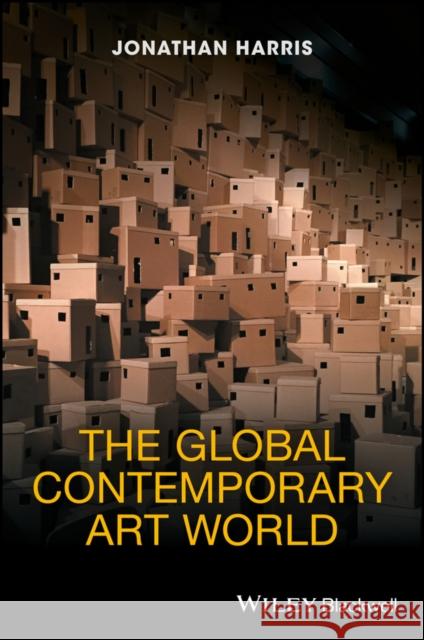The Global Contemporary Art World » książka



The Global Contemporary Art World
ISBN-13: 9781118338513 / Angielski / Miękka / 2017 / 240 str.
The Global Contemporary Art World
ISBN-13: 9781118338513 / Angielski / Miękka / 2017 / 240 str.
(netto: 175,80 VAT: 5%)
Najniższa cena z 30 dni: 182,70
ok. 30 dni roboczych.
Darmowa dostawa!
An Introduction. The final installment in the critically-acclaimed trilogy on globalization and art explores the growing dominance of Asian centers of art.
About the Author vii
Introduction: “Global,” “Contemporary,” “Art,” “World” 1
Entering the Maze 1
Modernity, Contemporary Art and Globalization 7
Five Asian Centers Within the Global Contemporary Art World 15
Global Crash, Crises and the Art World 20
Contemporary Art in the Friezer 25
1 Doing the Business: Producing Consumption in the Hong Kong Art World 35
Hong Kong Gets the Art Basel Treatment 35
Offshore Art Business in the Global Neoliberal Capitalist Economy 39
Combined and Uneven Development in the Hong Kong Art World 45
Hong Kong’s Art World Inside and Outside China 52
2 New Media Art and Cultural Globalism in South Korea 65
The Chic of Global “New Media Art” 65
Contemporary Art as Global Cultural Diplomacy 69
“Glocal Video”: Conventions and Critiques 73
Culture, Contemporaneity and the Postcolonial Artwork 76
The “Real DMZ Project”: Conflict Art in the Korean Peninsula 80
Contemporary Art Across Global Asia 85
3 Globalizing Indian Contemporary Art: The Biennial as Rhetorical Form 95
The Kochi Biennale Big Sell 96
Kochi as a Global Venue 99
Art at Kochi: Liberal Pluralism Versus Social Engagement with Globalization? 102
The Highs and Lows of Art, Media and Kochi Biennale Capital 108
Utopian Rhetoric in Contemporary Art at the Kochi Biennale 113
4 Social Reproduction of Contemporary Art in the People’s Republic of China: Higher Education and the Branding of “Contemporary Chinese Art” 127
Art and Design Education as a Globalization Process 127
Changing Identifications in Art and Design Education in China 132
Contemporary Chinese Art Marketed for Global Consumption 136
Chinese Art and the World Art System 141
5 Contemporary Art and Post–National Identities in the State of Palestine 155
“Palestine is Open for Business”! 155
Grounding the Culture Industry in Palestine 158
Palestinian Museums–of–art–in–waiting 162
The “NGO–ization” of the Contemporary Art World in the State of Palestine 167
Concrete into Dust 172
6 Conclusion: Motifs of Global Fracture in the Art Of Bashir Makhoul and Wang Guofeng 181
Re–Entering the Maze 181
In Girum Imus Nocte et Consumimur Igni 185
Utopian Photo–Mythologies 188
Aesthetic and Social Implications of Digital Photography 191
Aesthetic and Social Implications of Digital Technology 194
Selected Bibliography 201
Index 217
JONATHAN HARRIS is Head of Birmingham School of Art at Birmingham City University, UK. He has taught and lectured on modern and contemporary art at universities, museums and galleries worldwide for over thirty years. His The New Art History: A Critical Introduction (2001) remains a classic text, and he has published twenty books as editor, author and co–author, including Globalization and Contemporary Art and The Utopian Globalists (Wiley–Blackwell, 2011 and 2013).
This book takes readers on a fascinating journey around five Asian centers of contemporary art and its myriad institutions, agents, forms, materials, and languages, while posing vital questions about the political economy of culture and the power of visual art in a multi–polar world. The author analyzes the financial powerhouse of Art Basel Hong Kong, new media art in South Korea, the place of the Kochi Biennale within contemporary art in India, transnational art and art education in China, and the geo–politics of art patronage in Palestine, and develops a highly original synthesis of theoretical perspectives and empirical research.
Drawing on detailed case studies and personal insights gained from his extensive experience of the contemporary art scene in Asia, Jonathan Harris examines the evolving relationship between the western centers of art practice, collection, and validation and the emerging "peripheries" of Asian Tiger societies with burgeoning art centers. He also discusses the controversial question of whether the dominance of the art world is rapidly slipping away from Europe and North America.
The Global Contemporary Art World is essential reading for undergraduates and postgraduate students in modern and contemporary art, art history, art theory and criticism, cultural studies, the sociology of culture, and globalization studies. It is also a vital resource for research students, academics, and professionals in the art world.
1997-2026 DolnySlask.com Agencja Internetowa
KrainaKsiazek.PL - Księgarnia Internetowa









